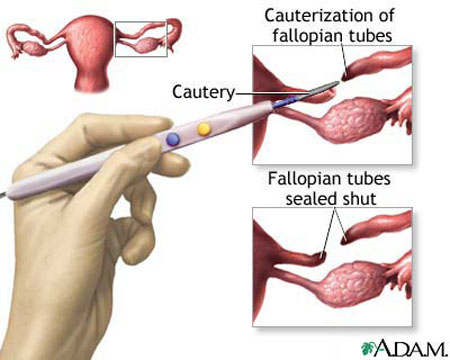Tubal Ligation procedure - risks, side effects

What is Tubal Ligation procedure
Tubal Ligation is a surgical OPERATION to sever (cut) or tie off a woman’s FALLOPIAN TUBES to prevent PREGNANCY. Tubal ligation is a form of permanent CONTRACEPTION, sometimes called tying the tubes or sterilization. There are two fallopian tubes, one leading from each ovary to the UTERUS. Cutting or cauterizing the fallopian tubes prevents the union of OVA, which travel from the OVARIES to the uterus, and SPERM, which travel from the uterus toward the ovaries. This blocks fertilization and prevents pregnancy.
Tubal Ligation - Surgical Procedure
The most common method of tubal ligation is an abdominal operation usually performed as a laparoscopic procedure in an AMBULATORY SURGICAL FACILITY (outpatient or same-day surgery). The doctor may also perform tubal ligation as an OPEN SURGERY at the conclusion of a scheduled CESAREAN SECTION, provided the woman has given informed consent for the procedure.
The woman first receives ANESTHESIA, which may be general anesthesia (deep sleep) or regional anesthesia such as an epidural block. The surgeon then makes a single incision (called a single puncture technique) or several small incisions near the area of the navel (belly button) to insert the laparoscope and operating instruments. The incisions give access to the fallopian tubes. The surgeon places surgical clips or uses cautery to close the tubes. There may or may not be SKIN sutures, depending on the method the surgeon uses. The operation typically takes 35 to 45 minutes.
The woman spends one to three hours in the recovery room after the operation, until she emerges from the effect of the anesthesia. Most women go home within four to six hours of the operation. There is some abdominal discomfort for one to three days, for which the doctor will prescribe or recommend appropriate ANALGESIC MEDICATIONS. Full recovery may take two to three weeks, though many women can return to most normal activities within a few days. INFERTILITY is immediate.
Tubal Ligation and Side Effects, Risks and Complications
As with any surgery, tubal ligation carries the risk for excessive bleeding, INFECTION, and reaction to the anesthesia. However, these complications are uncommon. Also possible though uncommon is PELVIC INFLAMMATORY DISEASE (PID), in which infection becomes widespread within the fallopian tubes and uterus and may also involve other abdominal structures. Rarely a fallopian tube may spontaneously reanastomose (reconnect), resulting in unexpected fertility usually detected through pregnancy.
Complications that may occur months to years after the operation include abdominal adhesions (the formation of restrictive SCAR tissue within the abdominal cavity) and ECTOPIC PREGNANCY, a lifethreatening circumstance that typically occurs when a tube partially reanastomoses but the fertilized egg cannot pass through the tube to the uterus and instead begins to grow in the fallopian tube or the abdominal cavity.
Outlook and Lifestyle Modifications
Tubal ligation has no effect on a woman’s LIBIDO (sex drive), and in fact may increase a woman’s interest in sexual activity because she no longer worries about unintended pregnancy. However, tubal ligation does not protect against SEXUALLY TRANSMITTED DISEASES (STDS) or HIV/AIDS.
The intent of tubal ligation is to establish permanent infertility (sterility), and a woman should consider tubal ligation to be permanent though it is sometimes possible to reverse a tubal ligation through a second surgery. The operation to reverse tubal ligation is usually major abdominal open surgery; its success depends on multiple factors, including the woman’s current age and the age at which she had the tubal ligation and the skill of the surgeon.
See also CONCEPTION; FAMILY PLANNING; SEXUALLY TRANSMITTED DISEASE (STD) PREVENTION; VASECTOMY.